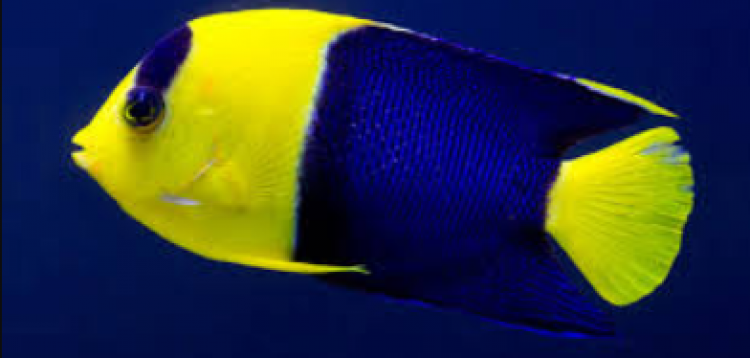- Name:
Ghost Bandit Angelfish
- Family:
- Species: Angel Dwarf
- Scientific Name: Apolemichthys arcuatus


General info about Ghost Bandit Angelfish
Ghost Bandit Angelfishes are commonly found on rocky reefs, in ledges and caves, and in coral areas. Visually, these angelfish are overall pale with a broad black bar bordered by a narrow pearly white band running across the upper side from the front of the eye to the posterior portion of the soft dorsal fin. A similar broad black band with pearly white border runs submarginal on the caudal and anal fins.
These dwarf angels are usually found in depth ranges of 25 to 50 m and may even reach up to 183 m. Hence when owning one is such a spectacular, rare, and very distinctive angelfish.
Ghost Bandit Angelfish Diet & Nutrition
Ghost bandit angelfish heavily rely on sponges with some algal matter for their diet in the wild. Hence, specimen from this species are difficult to maintain in an aquaria because of its specialized sponge and algal diet.
Determining Sex of Ghost Bandit Angelfish
Just like other marine angelfish, the Ghost Bandit Angelfish are protogynous hermaphrodites. They are born as females and will have sex reversal at adult stage for reproduction. Male Ghost Bandit Angelfish are usually larger than the female. This fish usually occurs in harems where a male is often in charge of many female, that when the male dies the next dominant female turns to assume the new male leader of the harem.
Breeding & Spawning Ghost Bandit Angelfish
Breeding of ghost bandit angelfish in home aquarium has been deemed as difficult but several aquaculture center has bred this species in captivity on a couple of occasions.
Common Diseases with Ghost Bandit Angelfish
Ghost bandit angelfish are delicate aquarium fish and is very sensitive during transportation. Hence, this dwarf angel may be able to contract physical ailments easily such as difficulty in decompressing. Physical ailments may include a bloated abdomen.
Some divers when collecting this species use a procedure called "needling" which pierces a small hole in the fish's air bladder to decompress, this may lead to complications such as bacterial infection. One major bacteria of concern is the Vibrio bacteria. It usually starts as an infection that turns into Dropsy, Popeye, Bleeding or Red Streaks on the skin. It is a very fast acting bacteria that can kill the fish within two days.
Ghost Bandit Angelfish Origin
Ghost Bandit Angelfish are endemic to the Hawaiian Islands and in Johnston Atoll.
Caution with Ghost Bandit Angelfish
It is not compatible to reef tanks, it survives best in fish-only-live-rock (FOLR) tanks since it is known to bite on sessile invertebrates such as sponges, stony and soft corals, and clam mantles. Ghost bandit are quite aggressive and territorial, hence it best to keep in large tanks to avoid competition for space and territory.
Ghost Bandit angelfish are known to have short lifespans when kept in an aquarium due to their sensitivity. Hence, they should be kept in optimal conditions for their survival
Acclimating Ghost Bandit Angelfish
In acquiring this individual for a tank, it is recommended that they are introduced as juveniles since it will acclimatize better in aquarium condition when introduced young.
Since Ghost Bandit angelfishes are used to faint light in natural conditions, it is recommended that tank light should be dimmed first when introducing the specimen and gradually increasing it to normal for acclimization. Also this species can be very shy when first introduced into the aquarium, once acclimatized more aggressive fish can be added into the tank.
Adequate amount of established living rocks with micro-invertebrates should be included to provide enough grazing, hiding, and swimming space to keep the fish active and healthy.
Original Detail
| Name | Species | Family | Scientific Name | More Detail | Added by |
|---|---|---|---|---|---|
| Ghost Bandit Angelfish | Angel Dwarf | Apolemichthys arcuatus | Ghost Bandit Angelfishes are commonly found on rocky reefs, in ledges and caves, and in coral areas. Visually, these angelfish are overall pale with a broad black bar bordered by a narrow pearly white band running across the upper side from the front of the eye to the posterior portion of the soft dorsal fin. A similar broad black band with pearly white border runs submarginal on the caudal and anal fins. These dwarf angels are usually found in depth ranges of 25 to 50 m and may even reach up to 183 m. Hence when owning one is such a spectacular, rare, and very distinctive angelfish. |
PalaciosAn |
Changed by users
| Submitted Date | Submitted By | Status | Action |
|---|




